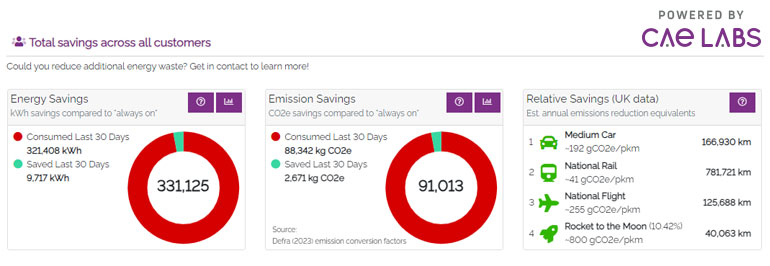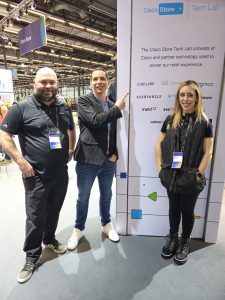Join us as we dive deeper into Cisco and Cisco partner technology deployed at the Cisco Store! We asked Ali McKeand (Chief Technologist for Innovation at CAE Labs) to discuss how their technology boosts sustainability efforts at the Cisco Store and larger retail environments. His work is focused on Cisco-based innovation and programmability, and he has been working with Cisco and various technologies over the last two decades.
How do CAE Labs improve a retailer’s and shopper’s in-store and/or virtual shopping experience? What problem is it solving?
We want to expedite how quickly we can deliver the value of new technology to both the retailer and their end customers. CAE Labs’ innovation enables and provides capabilities that deliver rapid adoption of Cisco technology, which in turn drives down project costs and time. We’ve built up deep domain knowledge and experience over the last three decades in retail and can effectively provision a new store location of Cisco technology in a couple of seconds rather than what traditionally might have taken numerous hours.
Buyers are far more conscious about the products and services they purchase, especially with brands that are driving decarbonization. Utilizing powerful programmatic platforms, such as Cisco Meraki (Cisco Networking Cloud), and solutions such as WiserWatts from CAE Labs help to optimize network services to only be delivered during core operating hours, powering them off for the remaining parts of the day. It really is making an impact in the sustainability space: so far, we are saving over 10,000 kWh of energy waste per 30 days across our customer base and saving many metric tons of carbon emissions.

What would you like people to know about WiserWatts when they see it in action at the Cisco Store Tech Lab?
I’d love people to know how the blend of Cisco technology with API programmability, through solutions such as WiserWatts, can lead to a much more carbon-friendly, energy-conscious approach to powering the Cisco Store’s technology — only when it’s needed during core hours as opposed to a typical always-on approach.
We saw WiserWatts showcased at Cisco Live: through the combination of its use with smart power controllers (Meraki MT40), power consumption can be tracked and device usage can be live scheduled, supporting the retailer to only power ‘on’ their devices during core operational hours. WiserWatts has also been implemented in a live environment at Cisco’s San Jose campus, realizing a 66% reduction in power consumption.
More than anything, I’d want people to see how we’ve been able to optimize the network at scale through refined automation. When it comes to decarbonization and saving on energy waste, there’s thousands of ways to do that, and most of those are quite difficult: not just to implement, but more importantly to track and measure and report on what’s been saved.
But our work at the Cisco Store showed that there are some easy-to-obtain use cases, such as powering off PoE (Power over Ethernet) drawing devices that aren’t needed 24/7. Another use case is being able to automate the turning off and on of smart power controllers [Meraki MT40] every day; that goes way outside of just the lens of networking. Anything that connects to a standard power cable (C13 plug) can be influenced and we can eliminate that energy waste, which then leads to saving even more on overall run costs or operating expenses and removes carbon emissions. It’s a great opportunity for Brian [Domine, the Cisco Store Tech Lab manager] and the Cisco Store team to be able to benchmark what the energy consumption is in that space for the first time.

How do you envision CAE Labs’ technology being used in retail environments in the future?
The areas we’re focused on are looking at how we provide retailers with service assurance when navigating their store infrastructure to the cloud — certainly Cisco Networking Cloud for Meraki and Catalyst devices. A lot of the capabilities we’ve been developing over the years have been around service assurance and sustainability, as well as refined automation and orchestration, which are looking at how we can make changes at scale with a store-as-code approach.
We’ve got great co-innovation experience with a large national retailer in the UK over the past 5+ years, where, for example, we were able to execute a change at scale across thousands of locations within an hour; it would have traditionally taken them around 3 months to implement such change and at a much higher cost. From an e-commerce business perspective, that rapid change helped them onboard new business partnerships far quicker with the likes of Amazon and Deliveroo.
We take this hyper Cisco focused programmatic codified approach to be able to manage, maintain and deliver value to large or small store estates. CAE Labs is trying to productize that approach, making it really easily accessible to consume and adopt.
That’s where I see our API-integrated value deliver at its best for customers: large multi-site customers that can be retail, but can equally benefit healthcare and schools with hundreds of locations. In retail, it’s about leveraging platforms like Cisco Meraki that help retailers adjust and adapt to forever-changing challenges as well as innovate quicker; the key to this is having a unified networking solution and foundation throughout all locations that enables a programmatic API-first approach.
What do you think will be a priority for shoppers in the next 5 years?
Frictionless experiences. We’ve seen that over the last few years with several retailers we’ve worked with: they’re spending significant amounts of energy, time, and money figuring out what great looks like in the form of frictionless consumption. One example is that self-checkout experiences have continually expanded, and a lot of our retailers have far fewer manned checkout lanes. We’re figuring out new ways in how we can leverage technology such as smart cameras and IoT sensors to improve the overall customer journey — from when they come in to when they leave — and we want to see how we can remove those friction points that hinder their experience.
Over the next 5 years, I can foresee there being less human presence in store estates, and more refinement on how we can get from A to B as quickly as possible using technology as the enabler. The Cisco Meraki platform is one of the best networking platforms out there to do that, as it combinates in solving many problems for retailers outside of just pure network connectivity like other competing vendors.
Likewise, what do you think will be a priority for retailers in the next 5 years?
Simplification of their technology stacks. Retail has gotten complex over the last five years, and especially over the pandemic a lot of ‘temp-tech’ was deployed to solve a pertinent timely problem, but not necessarily fully utilized and adopted. The bedrock and foundation of any retailer is the underlying infrastructure on which different colleague and customer experiences (and other retail technologies) operate and layer on top. The dawn of more easily attainable automation potentially helps this simplification as well.
We also can’t ignore security. The programmatic, scalable, and secure architecture from Cisco has been the winning platform for a lot of retail projects that we’ve done over the past decade.
Interested in learning more about CAE Labs? Visit our page or reach out now.

CONNECT WITH US